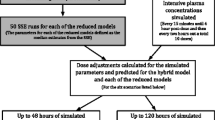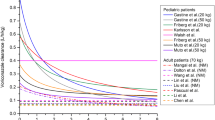Abstract
Model based personalised dosing (MBPD) is a sophisticated form of individualised therapy, where a population pharmacokinetic (PK) or pharmacodynamic model is utilised to estimate the dose required to reach a target exposure or effect. The choice of which model to implement in MBPD is a subjective decision. By choosing one model, information from the remaining models is ignored, as well as the rest of the literature base. This manuscript describes a methodology to develop a ‘hybrid’ model for voriconazole that incorporated information from prior models in a biologically plausible manner. Voriconazole is a triazole antifungal with difficult to predict PK, although it does have a defined exposure–response relationship. Nine population PK models of voriconazole were identified from the literature. The models differed significantly in structural components. The hybrid model contained a two-compartment disposition model with mixed linear and nonlinear time-dependent clearance. The parameters for the hybrid model were determined using simulation techniques. Validation of the hybrid model was assessed via visual predictive checks, which indicated the majority of the variability in the literature models was captured by the hybrid model. The predictive performance was assessed using four different sampling strategies of limited concentrations from ten richly PK sampled subjects to predict future concentrations. Overall, the hybrid model predicted future concentrations with good precision. Further prospective and retrospective validation of the hybrid model is required before it could be used in clinical practice.





Similar content being viewed by others
References
Sheiner LB (1969) Computer-aided long-term anticoagulation therapy. Comput Biomed Res Int Journal 2(6):507–518
Jelliffe R, Neely M, Schumitzky A, Bayard D, Van Guilder M, Botnen A, Bustad A, Laing D, Yamada W, Bartroff J, Tatarinova T (2011) Nonparametric population modeling and Bayesian analysis. Pharmacol Res Off J Ital Pharmacol Soc 64(4):426
Jelliffe RW, Schumitzky A, Bayard D, Milman M, Van Guilder M, Wang X, Jiang F, Barbaut X, Maire P (1998) Model-based, goal-oriented, individualised drug therapy. Linkage of population modelling, new ‘multiple model’ dosage design, Bayesian feedback and individualised target goals. Clin Pharmacokinet 34(1):57–77
Jelliffe RW, Schumitzky A, Van Guilder M, Liu M, Hu L, Maire P, Gomis P, Barbaut X, Tahani B (1993) Individualizing drug dosage regimens: roles of population pharmacokinetic and dynamic models, Bayesian fitting, and adaptive control. Ther Drug Monit 15(5):380–393
Upton RN, Mould DR (2014) Basic concepts in population modeling, simulation, and model-based drug development: part 3-introduction to pharmacodynamic modeling methods. CPT Pharmacomet Syst Pharmacol 3:e88
Mould DR, Upton RN (2012) Basic concepts in population modeling, simulation, and model-based drug development. CPT Pharmacomet Syst Pharmacol 1:e6
Mould DR, Upton RN (2013) Basic concepts in population modeling, simulation, and model-based drug development-part 2: introduction to pharmacokinetic modeling methods. CPT Pharmacomet Syst Pharmacol 2:e38
Roberts JA, Abdul-Aziz MH, Lipman J, Mouton JW, Vinks AA, Felton TW, Hope WW, Farkas A, Neely MN, Schentag JJ, Drusano G, Frey OR, Theuretzbacher U, Kuti JL, on behalf of The International Society of Anti-Infective Pharmacology and the Pharmacokinetics and Pharmacodynamics Study Group of the European Society of Clinical Microbiology and Infectious Diseases (2014) Individualised antibiotic dosing for patients who are critically ill: challenges and potential solutions. Lancet Infect Dis 14 (6):498–509
Lepak AJ, Andes DR (2011) Antifungal PK/PD considerations in fungal pulmonary infections. Semin Respir Crit Care Med 32(6):783–794
Han K, Capitano B, Bies R, Potoski BA, Husain S, Gilbert S, Paterson DL, McCurry K, Venkataramanan R (2010) Bioavailability and population pharmacokinetics of voriconazole in lung transplant recipients. Antimicrob Agents Chemother 54(10):4424–4431
Hope WW (2012) Population pharmacokinetics of voriconazole in adults. Antimicrob Agents Chemother 56(1):526–531
Dolton MJ, Ray JE, Chen SC, Ng K, Pont LG, McLachlan AJ (2012) Multicenter study of voriconazole pharmacokinetics and therapeutic drug monitoring. Antimicrob Agents Chemother 56(9):4793–4799
Pascual A, Csajka C, Buclin T, Bolay S, Bille J, Calandra T, Marchetti O (2012) Challenging recommended oral and intravenous voriconazole doses for improved efficacy and safety: population pharmacokinetics-based analysis of adult patients with invasive fungal infections. Clin Infect Dis 55(3):381–390
Hamada Y, Seto Y, Yago K, Kuroyama M (2012) Investigation and threshold of optimum blood concentration of voriconazole: a descriptive statistical meta-analysis. J Infect Chemother 18(4):501–507
Miyakis S, van Hal SJ, Ray J, Marriott D (2010) Voriconazole concentrations and outcome of invasive fungal infections. Clin Microbiol Infect 16(7):927–933
Pascual A, Calandra T, Bolay S, Buclin T, Bille J, Marchetti O (2008) Voriconazole therapeutic drug monitoring in patients with invasive mycoses improves efficacy and safety outcomes. Clin Infect Dis 46(2):201–211
Retout S, Mentré F (2003) Further developments of the Fisher information matrix in nonlinear mixed effects models with evaluation in population pharmacokinetics. J Biopharm Stat 13(2):209–227
Dolton MJ, Mikus G, Weiss J, Ray JE, McLachlan AJ (2014) Understanding variability with voriconazole using a population pharmacokinetic approach: implications for optimal dosing. J Antimicrob Chemother 69(6):1633–1641
Wang T, Chen S, Sun J, Cai J, Cheng X, Dong H, Wang X, Xing J, Dong W, Yao H, Dong Y (2013) Identification of factors influencing the pharmacokinetics of voriconazole and the optimization of dosage regimens based on Monte Carlo simulation in patients with invasive fungal infections. J Antimicrob Chemother 69(2):463–470
Friberg LE, Ravva P, Karlsson MO, Liu P (2012) Integrated population pharmacokinetic analysis of voriconazole in children, adolescents, and adults. Antimicrob Agents Chemother 56(6):3032–3042
Karlsson MO, Lutsar I, Milligan PA (2009) Population pharmacokinetic analysis of voriconazole plasma concentration data from pediatric studies. Antimicrob Agents Chemother 53(3):935–944
Han K, Bies R, Johnson H, Capitano B, Venkataramanan R (2011) Population pharmacokinetic evaluation with external validation and Bayesian estimator of voriconazole in liver transplant recipients. Clin Pharmacokinet 50(3):201–214
Nomura K, Fujimoto Y, Kanbayashi Y, Ikawa K, Taniwaki M (2008) Pharmacokinetic–pharmacodynamic analysis of voriconazole in Japanese patients with hematological malignancies. Eur J Clin Microbiol Infect Dis 27(11):1141–1143
Bonate PL (2005) Pharmacokinetic–pharmacodynamic modeling and simulation. Springer, New York
McLeay SC, Morrish GA, Kirkpatrick CMJ, Green B (2012) The relationship between drug clearance and body size: systematic review and meta-analysis of the literature published from 2000 to 2007. Clin Pharmacokinet 51(5):319–330
Holford N (2005) The Visual Predictive Check Superiority to Standard Diagnostic (Rorschach) Plots. Paper presented at the PAGE 14, Pamplona, Spain. http://www.page-meeting.org/?abstract=738. Accessed 1 Dec 2015
Continuous National Health and Nutrition Examination Survey. National Center for Health Statistics Center for Disease Control and Prevention. http://wwwn.cdc.gov/nchs/nhanes/search/nhanes_continuous.aspx. Accessed 29 April 2015
Brüggemann RJM, Blijlevens NMA, Burger DM, Franke B, Troke PF, Donnelly JP (2010) Pharmacokinetics and safety of 14 days intravenous voriconazole in allogeneic haematopoietic stem cell transplant recipients. J Antimicrob Chemother 65(1):107–113
Anderson BJ, Holford NHG (2008) Mechanism-based concepts of size and maturity in pharmacokinetics. Annu Rev Pharmacol Toxicol 48:303–332
Janmahasatian S, Duffull SB, Ash S, Ward LC, Byrne NM, Green B (2005) Quantification of lean bodyweight. Clin Pharmacokinet 44(10):1051–1065
(CDC). CfDCaP (2014) National Health and Nutrition Examination Survey Data. National Center for Health Statistics (NCHS), Hyattsville, MD
Al-Sallami H, Goulding A, Taylor R, Grant A, Williams S, Duffull S (2011) A semi-mechanistic model for estimating fat free mass in children. Paper presented at the Population Analysis Group Europe, Athens. http://www.page-meeting.org/page/page2011/PAGEPosters.pdf. Accessed 1 Dec 2015
Development Core Team R (2014) R: a language and environment for statistical computing. R Found Stat Comput, Vienna
Damle B, Varma MV, Wood N (2011) Pharmacokinetics of voriconazole administered concomitantly with fluconazole and population-based simulation for sequential use. Antimicrob Agents Chemother 55(11):5172–5177
Green B, Duffull SB (2004) What is the best size descriptor to use for pharmacokinetic studies in the obese. Br J Clin Pharmacol 58(2):119–133
Gilbert DN The Sanford guide to antimicrobial therapy 2011. Antimicrobial Therapy, Inc., Sperryville
Rengelshausen J, Banfield M, Riedel K-D, Burhenne J, Weiss J, Thomsen T, Walter-Sack I, Haefeli WE, Mikus G (2005) Opposite effects of short-term and long-term St John’s wort intake on voriconazole pharmacokinetics. Clin Pharmacol Ther 78(1):25–33
Alffenaar J-WC, van der Elst KCM, Uges DRA, Kosterink JGW, Daenen SMGJ (2009) Phenytoin-induced reduction of voriconazole serum concentration is not compensated by doubling the dosage. Br J Clin Pharmacol 68(3):462–463
Purkins L, Wood N, Ghahramani P, Love ER, Eve MD, Fielding A (2003) Coadministration of voriconazole and phenytoin: pharmacokinetic interaction, safety, and toleration. Br J Clin Pharmacol 56(Suppl 1):37–44
Spriet I, Meersseman P, Meersseman W, de Hoon J, Willems L (2010) Increasing the dose of voriconazole compensates for enzyme induction by phenytoin. Br J Clin Pharmacol 69(6):701–702
Verweij PE, de Pauw BE, Meis JF (1999) Voriconazole (Pfizer ltd). IDrugs 2(9):925–937
Hyland R, Jones BC, Smith DA (2003) Identification of the cytochrome P450 enzymes involved in the N-oxidation of voriconazole. Drug Metab Dispos 31(5):540–547
Koselke E, Kraft S, Smith J, Nagel J (2012) Evaluation of the effect of obesity on voriconazole serum concentrations. J Antimicrob Chemother 67(12):2957–2962
Hoenigl M, Duettmann W, Raggam RB, Seeber K, Troppan K, Fruhwald S, Prueller F, Wagner J, Valentin T, Zollner-Schwetz I, Wölfler A, Krause R (2013) Potential factors for inadequate voriconazole plasma concentrations in intensive care unit patients and patients with hematological malignancies. Antimicrob Agents Chemother 57(7):3262–3267
Han PY, Duffull SB, Kirkpatrick CM, Green B (2007) Dosing in obesity: a simple solution to a big problem. Clin Pharmacol Ther 82(5):505–508
Pai MP, Lodise TP (2011) Steady-state plasma pharmacokinetics of oral voriconazole in obese adults. Antimicrob Agents Chemother 55(6):2601–2605
Theuretzbacher U, Ihle F, Derendorf H (2006) Pharmacokinetic/pharmacodynamic profile of voriconazole. Clin Pharmacokinet 45(7):649–663
Purkins L, Wood N, Kleinermans D, Greenhalgh K, Nichols D (2003) Effect of food on the pharmacokinetics of multiple-dose oral voriconazole. Br J Clin Pharmacol 56(Suppl 1):17–23
Yanni SB, Annaert PP, Augustijns P, Ibrahim JG, Benjamin DK Jr, Thakker DR (2010) In vitro hepatic metabolism explains higher clearance of voriconazole in children versus adults: role of CYP2C19 and flavin-containing monooxygenase 3. Drug Metab Dispos 38(1):25–31
Acknowledgments
D.A.J.M. is supported by an Australian Postgraduate Award.
Author information
Authors and Affiliations
Corresponding author
Ethics declarations
Conflict of interest
B.G. and J.M. declare no conflicts of interest. E.G.P. is a member of the Antifungal Advisory Boards of Pfizer and Merck.
Electronic supplementary material
Below is the link to the electronic supplementary material.
Rights and permissions
About this article
Cite this article
McDougall, D.A.J., Martin, J., Playford, E. et al. Determination of a suitable voriconazole pharmacokinetic model for personalised dosing. J Pharmacokinet Pharmacodyn 43, 165–177 (2016). https://doi.org/10.1007/s10928-015-9462-9
Received:
Accepted:
Published:
Issue Date:
DOI: https://doi.org/10.1007/s10928-015-9462-9




